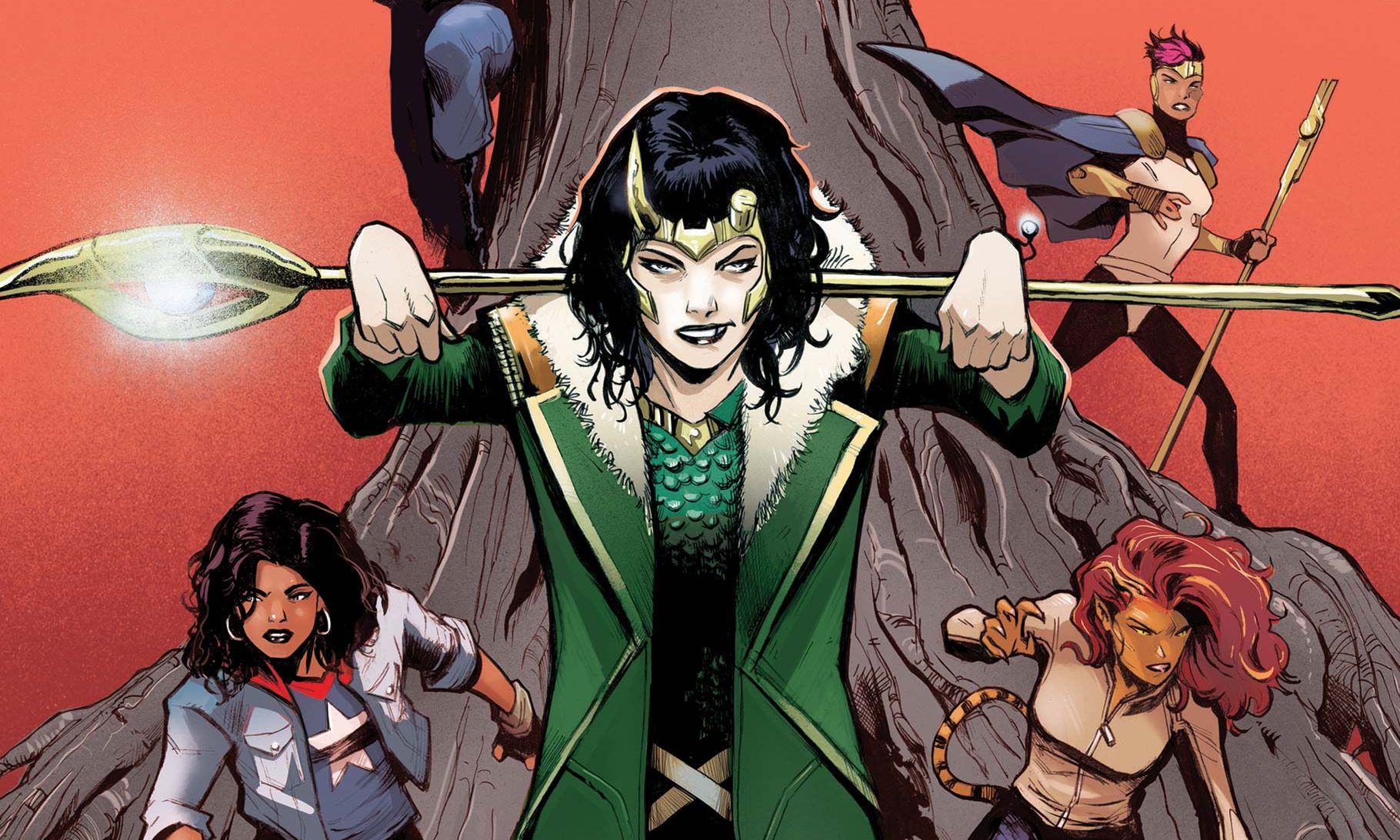This New Marvel Series May Feature the Best Lady Loki Yet

Marvel Comics’s Defenders: Beyond wrapped up last week, and it might be my new favorite comic series. A 5-issue limited run, Defenders: Beyond is a sequel to the first Defenders limited series, written by Al Ewing and drawn by Javier Rodríguez. There’s so much to love about this series! It’s high-concept science fiction that explores metaphysical questions like predestination, cyclical time, and the nature of God. It’s got America Chavez punching the Beyonder across multiple plains of reality. It features Taaia of Taa, who’s Galactus’s mom and my favorite obscure Marvel character. The whole story is a mind-bending delight, but what I love the most about it is its depiction of Lady Loki.
Warning: spoilers ahead! However, the pleasure of this series doesn’t really lie in any shocking twists or reveals, so I bet you’ll still love it if you know how it ends.
A note on pronouns: Loki’s pronouns change based on who’s writing the character, but since Defenders: Beyond switches between he and she, I’ll do the same here.
Here’s what happens in Defenders: Beyond
The story is a continuation of Loki: Agent of Asgard, which ends with Loki walking through a doorway labeled “NEXT.” Loki comes out of that doorway in Thor #24, makes a pitstop to pick up Taaia, and then uses a deck of tarot cards to gather Blue Marvel, America Chavez, and Tigra. Together, the five Defenders travel through the cosmos to find the enemy of Eternity (whom we met in the Marvel Cinematic Universe’s Thor: Love and Thunder).
Although Loki starts off as male, he shifts back and forth between male and female forms throughout the story, and she happens to spend most of her time as female.
This Loki is truly genderfluid
Usually, Lady Loki—that is, Loki in her female form—is presented as feminine and seductive. (Which is great! I love her in all her forms.) In this series, though, she has the same tattered coat, messy hair, and missing tooth that she does when she’s male. Her presentation is part of what allows her to shift genders so easily throughout the story, leaning into her genderfluidity.
This portrayal of her is refreshing after the MCU’s treatment of genderfluidity. If you’ve read my past coverage of Loki on Disney Plus, you know that I love it and I can’t wait for more. So, I say this as a big fan of the series: Despite everything it did right, it messed up genderfluidity big time. Making Sylvie a multiversal variant wasn’t a problem to me—but having all the male Lokis be shocked by the possibility of a female Loki was a big disappointment, especially after “our” Loki’s gender was listed as “fluid” in his TVA file.
Defenders goes in a very different direction. Loki presents as different genders from moment to moment, sometimes looking overtly male or female, other times looking more androgynous. Even better, the other characters don’t blink when she changes. They just adjust their pronouns accordingly and focus on the task at hand. Ewing’s writing and Rodríguez’s art normalize genderfluidity in a way that the MCU hasn’t come close to doing.
But that’s not the only reason this Loki is so cool. She’s also a bodhisattva.
Loki is a bodhisattva now? I dig it
At the end of the series, Loki reveals why she’s assembled the team. After multiple lifetimes of being forced into the role of a villain—by circumstance, by their mother Freya, by their own older self—Loki wants to end the cycle and leave the multiverse so that she can be free. At the beginning of the story, she confesses to her older self that “I’m scared you’ll go backwards. That my future’s going to be my past, again and again and again, no matter what…”
However, when she tells the other Defenders her plan, they offer her another choice: She can go back to her role as the God of Stories and take a bodhisattva vow. In Buddhism, a bodhisattva is a being who reaches enlightenment, but remains in the cycle of death and rebirth until all other beings are enlightened, too. Loki is intrigued by the idea of devoting her existence to helping others find freedom, and she decides to do it. She’s popped back into the multiverse, where he wakes up as Marvel’s current Loki, ruler of Jotunheim and ally to Thor.
(Also, the bodhisattva vow is foreshadowed in issue 4 when Loki unwillingly becomes a tree for a few minutes, which echoes the myth of the Buddha under the Bodhi Tree. It’s such a smart moment! This series is so well done! Go read it if you haven’t already!)
A bodhisattva might seem like an overly lovey-dovey concept to someone who doesn’t know much about Buddhism, but I love the idea of a trickster god vowing to help liberate all other living things. Tricksters in mythology are known for helping those with less power than them—think of Raven stealing the Sun to give it to humans, for example, or Prometheus stealing fire. Loki as a trickster and a hero makes perfect sense, and his grin in the last panel makes it clear that he’ll keep his edge.
Loki will presumably continue his adventures in the Thor comics, and the second season of the MCU’s Loki is coming this summer. I don’t know how other writers will tackle the character, but I’m so glad I got to spend some time with this version of her.
(featured image: Marvel)
Have a tip we should know? tips@themarysue.com